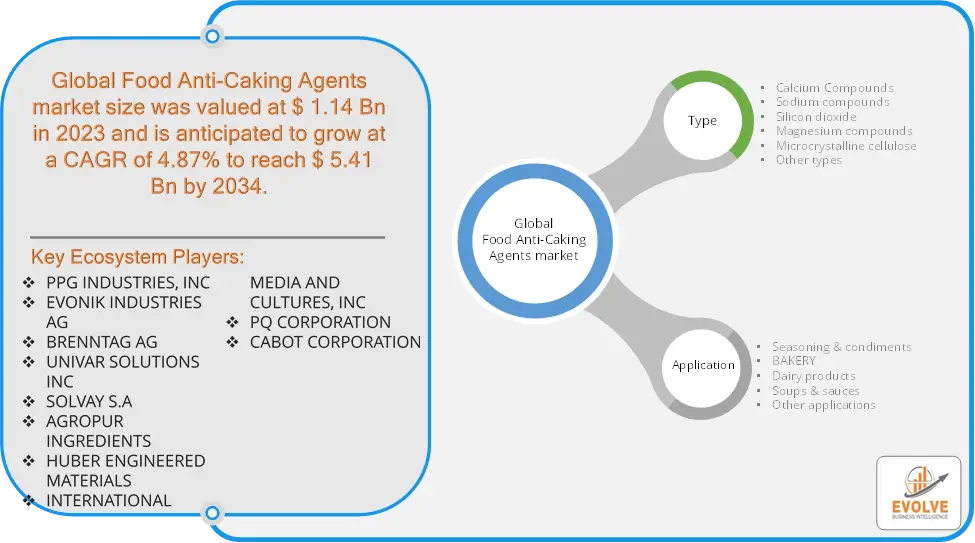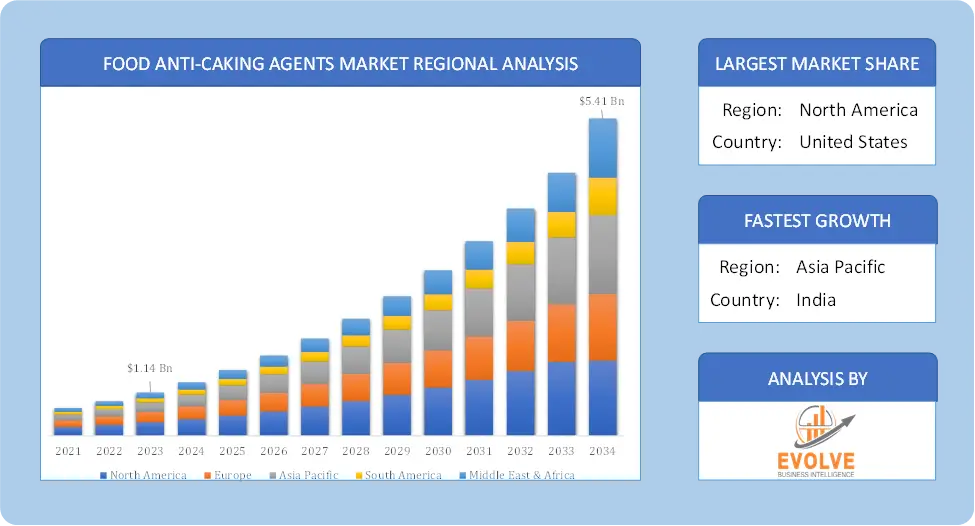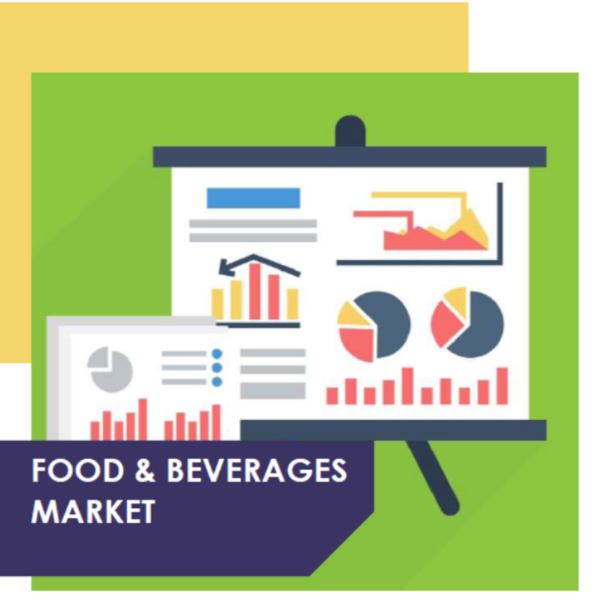Food Anti-Caking Agents Market Overview
The Food Anti-Caking Agents Market size accounted for USD 1.14 Billion in 2023 and is estimated to account for 1.68 Billion in 2024. The Market is expected to reach USD 5.41 Billion by 2034 growing at a compound annual growth rate (CAGR) of 4.87% from 2024 to 2034. The Food Anti-Caking Agents Market focuses on products that prevent clumping and ensure the free-flowing nature of powdered or granular food products. These agents are commonly used in salt, sugar, powdered spices, and other food ingredients to maintain their quality and ease of use. The market includes various types of anti-caking agents, such as silicon dioxide, calcium silicate, and magnesium stearate. Factors driving market growth include increasing demand for processed foods and convenience products, along with innovations in food processing technologies. Key players in the market are constantly developing new formulations to enhance performance and meet regulatory standards. The market is influenced by trends towards healthier eating and natural ingredients, leading to a rise in demand for organic and non-synthetic anti-caking agents.
Global Food Anti-Caking Agents Market Synopsis
 Food Anti-Caking Agents Market Dynamics
Food Anti-Caking Agents Market Dynamics
The major factors that have impacted the growth of Food Anti-Caking Agents are as follows:
Drivers:
Ø Technological Advancements in Food Processing
Innovations in food processing technologies and the development of advanced anti-caking formulations are enhancing the performance and efficacy of these agents. New technologies help improve the efficiency of anti-caking agents, making them more effective and versatile.
Restraint:
- High Costs of Natural Alternatives
While there is a shift towards natural anti-caking agents, they often come with higher costs compared to synthetic options. The higher price of natural alternatives can be a significant restraint, especially for manufacturers aiming to keep product costs low while meeting consumer demands.
Opportunity:
⮚ Technological Advancements
Advances in food processing technology present opportunities for improving the performance and efficacy of anti-caking agents. Innovations such as microencapsulation and the development of new formulations can enhance the functionality of these agents, leading to better product stability and consumer satisfaction.
Food Anti-Caking Agents Segment Overview
By Type
 Based on Type, the market is segmented based on Calcium Compounds, Sodium Compounds, Silicon Dioxide, Magnesium Compounds, Microcrystalline Cellulose, Other Types. Silicon Dioxide is the dominant segment due to its widespread use and effectiveness in preventing clumping in various food products.
Based on Type, the market is segmented based on Calcium Compounds, Sodium Compounds, Silicon Dioxide, Magnesium Compounds, Microcrystalline Cellulose, Other Types. Silicon Dioxide is the dominant segment due to its widespread use and effectiveness in preventing clumping in various food products.
By Application
Based on Applications, the market has been divided into the Seasoning & Condiments, Bakery, Dairy Products, Soups & Sauces, Other Applications. the Seasoning & Condiments segment typically dominates due to the high demand for free-flowing spices and seasonings in both industrial and consumer applications.
Global Food Anti-Caking Agents Market Regional Analysis
Based on region, the global Food Anti-Caking Agents market has been divided into North America, Europe, Asia-Pacific, the Middle East & Africa, and Latin America. Asia-Pacific is projected to dominate the use of the Food Anti-Caking Agents market followed by the North America and Europe regions.
 Global Food Anti-Caking Agents North America Market
Global Food Anti-Caking Agents North America Market
North America holds a dominant position in the Food Anti-Caking Agents Market. In North America, the Food Anti-Caking Agents market is driven by a strong demand for processed and convenience foods, coupled with stringent food safety regulations. The region’s focus on product quality and innovation supports the use of advanced anti-caking solutions. Additionally, the increasing consumer preference for natural and organic food products is fueling the demand for natural anti-caking agents.
Global Food Anti-Caking Agents Asia-Pacific Market
The Asia-Pacific region has indeed emerged as the fastest-growing market for the Food Anti-Caking Agents industry. In the Asia-Pacific region, the Food Anti-Caking Agents market is experiencing robust growth due to the rising demand for processed and packaged foods driven by urbanization and increasing disposable incomes. The expansion of the food and beverage industry and rapid economic development in emerging markets like China and India further fuel market growth. Additionally, there is a growing interest in innovative and natural anti-caking solutions as consumers become more health-conscious.
Competitive Landscape
The global Food Anti-Caking Agents market is highly competitive, with numerous players offering a wide range of software solutions. The competitive landscape is characterized by the presence of established companies, as well as emerging startups and niche players. To increase their market position and attract a wide consumer base, the businesses are employing various strategies, such as Type launches, and strategic alliances.
Prominent Players:
- PPG INDUSTRIES, INC
- EVONIK INDUSTRIES AG
- BRENNTAG AG
- UNIVAR SOLUTIONS INC
- SOLVAY S.A
- AGROPUR INGREDIENTS
- HUBER ENGINEERED MATERIALS
- INTERNATIONAL MEDIA AND CULTURES, INC
- PQ CORPORATION
- CABOT CORPORATION
Key Development
In July 2019, Solvay reported an extension at its hydrogen peroxide plant in Jemeppe-sur-Sambre (Belgium), permitting an increment of hydrogen peroxide creation. These ventures satisfy the developing item need in Europe, in existing and new applications.
Scope of the Report
Global Food Anti-Caking Agents Market, by Type
- Calcium Compounds
- Sodium compounds
- Silicon dioxide
- Magnesium compounds
- Microcrystalline cellulose
- Other types
Global Food Anti-Caking Agents Market, by Application
- Seasoning & condiments
- BAKERY
- Dairy products
- Soups & sauces
- Other applications
Global Food Anti-Caking Agents Market, by Region
- North America
- US
- Canada
- Mexico
- Europe
- UK
- Germany
- France
- Italy
- Spain
- Benelux
- Nordic
- Rest of Europe
- Asia Pacific
- China
- Japan
- South Korea
- Indonesia
- Austalia
- Malaysia
- India
- Rest of Asia Pacific
- South America
- Brazil
- Argentina
- Rest of South America
- Middle East & Africa
- Saudi Arabia
- UAE
- Egypt
- South Africa
- Rest of Middle East & Africa
| Parameters | Indicators |
|---|---|
| Market Size | 2033: $5.41 Billion |
| CAGR | 4.87% CAGR (2023-2033) |
| Base year | 2022 |
| Forecast Period | 2023-2033 |
| Historical Data | 2021 |
| Report Coverage | Revenue Forecast, Competitive Landscape, Growth Factors, and Trends |
| Key Segmentations | Type, Application |
| Geographies Covered | North America, Europe, Asia-Pacific, Latin America, Middle East, Africa |
| Key Vendors | PPG INDUSTRIES, INC, EVONIK INDUSTRIES AG, BRENNTAG AG, UNIVAR SOLUTIONS INC, SOLVAY S.A, AGROPUR INGREDIENTS, HUBER ENGINEERED MATERIALS, INTERNATIONAL MEDIA AND CULTURES, INC, PQ CORPORATION, CABOT CORPORATION |
| Key Market Opportunities | • The adoption of artificial intelligence and the internet of things enhances the production of seaweed |
| Key Market Drivers | • A huge increase in demand for natural extracts of food for providing various health benefits |
REPORT CONTENT BRIEF:
- High-level analysis of the current and future Food Anti-Caking Agents market trends and opportunities
- Detailed analysis of current market drivers, restraining factors, and opportunities in the future
- Food Anti-Caking Agents market historical market size for the year 2022, and forecast from 2021 to 2034
- Food Anti-Caking Agents market share analysis at each Type level
- Competitor analysis with detailed insight into its Type segment, Government & Defense strength, and strategies adopted.
- Identifies key strategies adopted including Type launches and developments, mergers and acquisitions, joint ventures, collaborations, and partnerships as well as funding taken and investment done, among others.
- To identify and understand the various factors involved in the global Food Anti-Caking Agents market affected by the pandemic
- To provide a detailed insight into the major companies operating in the market. The profiling will include the Government & Defense health of the company’s past 2-3 years with segmental and regional revenue breakup, Type offering, recent developments, SWOT analysis, and key strategies.









